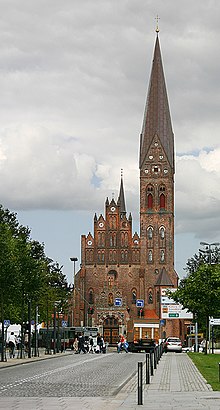
Odense is the third largest city in Denmark and the largest city on the island of Funen. As of 1 January 2024, the city proper had a population of 183,763 while Odense Municipality had a population of 209,078, making it the fourth largest municipality in Denmark. Eurostat and OECD have used a definition for the Metropolitan area of Odense, which includes all municipalities in the Province of Funen, with a total population of 504,066 as of 1 July 2022.

St. Canute's Cathedral, also known as Odense Cathedral, is named after the Danish king Canute the Saint, otherwise Canute IV. It is a fine example of Brick Gothic architecture. The church's most visited section is the crypt where the remains of Canute and his brother Benedict are on display.

Canute IV, later known as Canute the Holy or Saint Canute, was King of Denmark from 1080 until 1086. Canute was an ambitious king who sought to strengthen the Danish monarchy, devotedly supported the Roman Catholic Church, and had designs on the English throne. Slain by rebels in 1086, he was the first Danish king to be canonized. He was recognized by the Roman Catholic Church as patron saint of Denmark in 1101.

Saint Alban is venerated as the first-recorded British Christian martyr, for which reason he is considered to be the British protomartyr. Along with fellow Saints Julius and Aaron, Alban is one of three named martyrs recorded at an early date from Roman Britain. He is traditionally believed to have been beheaded in Verulamium sometime during the 3rd or 4th century, and has been celebrated there since ancient times.

The Catholic Church in Denmark is part of the worldwide Catholic Church, under the spiritual leadership of the Pope in Rome. The Diocese of Copenhagen covers the whole of the country, as well as the Faroe Islands and Greenland, and as such is one of the geographically largest Catholic dioceses by area in the world.
Ælnoth or Ailnoth was an Anglo-Saxon Benedictine monk from Canterbury who settled in Denmark, and is known as author of a legend of the Danish king Saint Canute, who had been killed in Odense in 1086 and was canonized by the Pope 1100 or 1101.

The former Diocese of Odense was a Roman Catholic diocese in Denmark which included the islands of Funen, Langeland, Tåsinge, Lolland, Falster, Als, and Ærø. Its episcopal see was located in Odense at St. Canute's Cathedral.
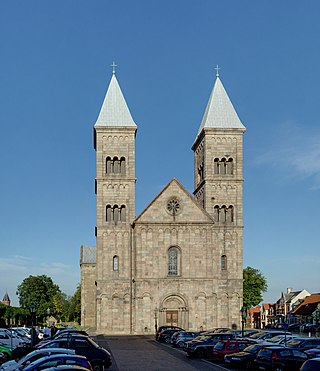
Viborg Cathedral, Our Lady Cathedral is the site of one of Denmark's most important historic churches located in the town of Viborg in northern Jutland. The modern building is a 19th-century construction based on Lund Cathedral in southern Sweden which bears no resemblance to the medieval cathedral that stood on the site since 1130.
Saint Canute's Abbey, Odense was a Benedictine monastery built to support the pilgrimage centre for the relics of the royal Danish martyr Saint Canute, and was the successor to the priory of St. Mary and St. Alban, Denmark's earliest monastic house. Located in Odense, it was the island of Funen's most important medieval religious institution.

St. Catherine's Priory was an important early Dominican friary, located in Ribe, Denmark from 1228 until 1536. The buildings still stand, although there is no monastic community there. Known as Ribe Kloster, it is Denmark's most complete extant monastic building complex.

St Dominic's Priory Church is one of the largest Catholic churches in London. The church is Grade II* listed building on the National Heritage List for England. It has been served by the Order of Preachers (Dominicans) since 1861, the community living in the adjacent Priory. In October 2016, the church was solemnly inaugurated by the Cardinal Archbishop of Westminster, Vincent Nichols, as a diocesan shrine, with a designated mission of promoting the Rosary.
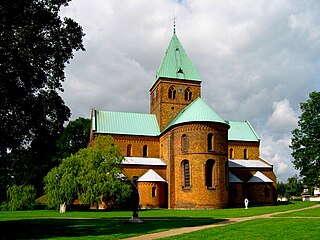
St. Bendt's Church is a church in Ringsted, Denmark, which was originally part of a Benedictine monastery that burnt down in the 18th century. Built in the Romanesque style, it is the oldest brick church in Scandinavia, dating back to about 1170 when it replaced a travertine church from about 1080. It is considered to be one of Denmark's architecturally finest churches. Furthermore, it is of special historical interest as it is the first Royal church in Denmark and it houses the tombs of many of Denmark's earlier monarchs and noblemen.

Saint Ansgar's Cathedral in Copenhagen, Denmark is the principal church of the Roman Catholic Diocese of Copenhagen, which encompasses all of Denmark, including the Faroe Islands and Greenland. It was consecrated in 1842 and became a cathedral in 1941.

St. Nicolas' Church with its distinctive tower is the parish church of Rønne on the island of Bornholm in the Diocese of Copenhagen. Enlarged and fully refurbished in 1918, it stands near the harbour on the site of an earlier church or chapel from the 13th century.
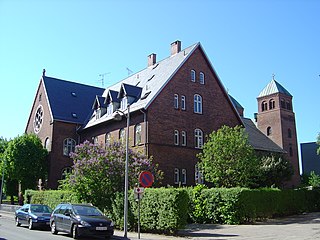
St. Anne's Church is a Roman-Catholic church in Sundby on Amager in Copenhagen, Denmark. It is located just off Amagerbrogade, next to Eberts Villaby. The church is closely affiliated with the nearby St. Ann's School.
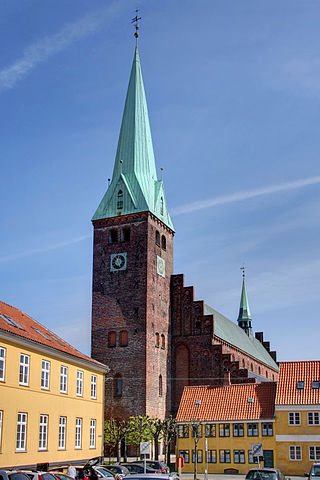
Saint Olaf's Church is the cathedral church of Helsingør in the north of Zealand, Denmark. With a history going back to around 1200, the present building was completed in 1559. In 1961, the church was given the status of cathedral in connection with the establishment of the Diocese of Helsingør.
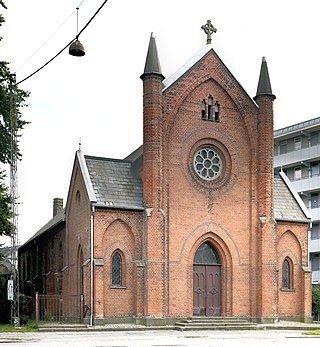
Saint Nikolaj Church is a church in Aarhus, Denmark. The church is situated in the Indre by neighbourhood on the western edge of the City Hall Park and was completed in 1893 from a design by Emanuel Edvard Christie Fleischer and Hjalmar Kjær in the Neo-Romanesque style. Saint Nikolaj Church is today owned and operated by the Catholic Church in Denmark and home to the local Chaldean congregation in Aarhus. The church is 700 square meters and holds 28 benches which can seat up to 300 people.
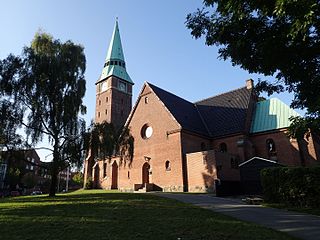
St. John's Church is a congregation of the Church of Denmark in Aarhus, Denmark. The parish church is situated in the Trøjborg neighbourhood, immediately north-west of Nordre Cemetery. In 2015, Saint Johannes Parish counted some 8,916 members.
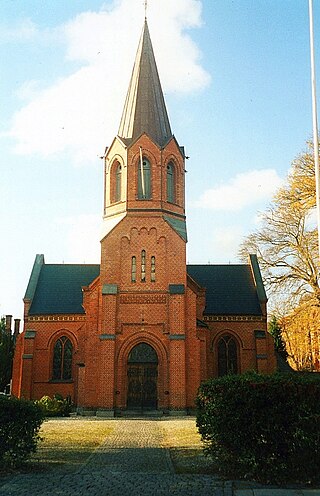
St. Andrew's Church is a Roman Catholic church in Ordrup, Gentofte Municipality, Copenhagen, Denmark.

St. Theresa's Church is a Roman Catholic church located at Bernstorffsvej on Hellerup, Gentofte Municipality, Copenhagen, Denmark. It is part of a larger complex which also comprises Rygaards International School.
